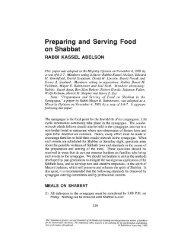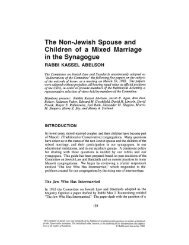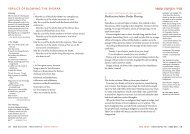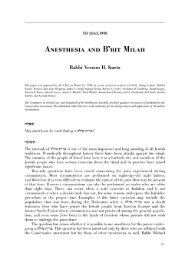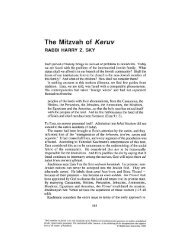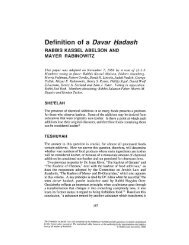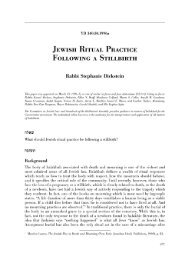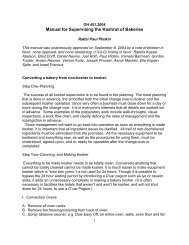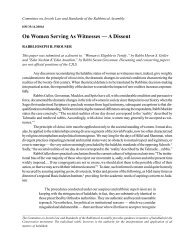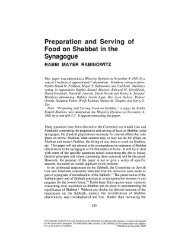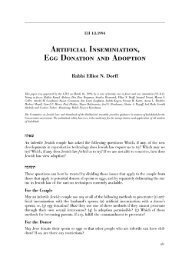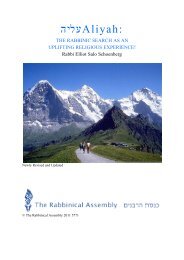Burial of a Non Jewish Spouse and Children - The Rabbinical ...
Burial of a Non Jewish Spouse and Children - The Rabbinical ...
Burial of a Non Jewish Spouse and Children - The Rabbinical ...
Create successful ePaper yourself
Turn your PDF publications into a flip-book with our unique Google optimized e-Paper software.
sidewalk <strong>of</strong> four amot (1.9 or 2.3 meters) wide” 49 , which is easily crossed, sends a message that<br />
the non-<strong>Jewish</strong> spouse was a part <strong>of</strong> the present day extended <strong>Jewish</strong> community.<br />
<strong>The</strong> Funeral<br />
<strong>The</strong> funerals <strong>of</strong> these non-<strong>Jewish</strong> spouses <strong>and</strong> children are a sensitive matter. <strong>The</strong> funeral, both<br />
at the Funeral Home <strong>and</strong> at the <strong>Jewish</strong> Cemetery should not contain non-<strong>Jewish</strong> ritual. <strong>The</strong><br />
ceremony could include Psalms such as Psalm 23, a eulogy, <strong>and</strong> appropriate prayers as<br />
determined by the local rabbi. <strong>Jewish</strong> relatives may elect to say a Kaddish 50 in memory <strong>of</strong> the<br />
deceased. <strong>The</strong>y may elect to say the Kaddish for thirty days or eleven or twelve months, as<br />
appropriate. <strong>The</strong> tombstone should not have any non-<strong>Jewish</strong> religious symbols engraved on it. 51<br />
Summary<br />
<strong>The</strong>re is no specific prohibition in the entire Bible dealing with burying non-Jews together with<br />
Jews. <strong>Jewish</strong> graves in Biblical times were privately owned caves or tombs reserved for family<br />
members, though there is mention <strong>of</strong> "the graves <strong>of</strong> common people." This continued to be the<br />
practice in Talmudic times. <strong>The</strong> history <strong>of</strong> the development <strong>of</strong> <strong>Jewish</strong> communal cemeteries is<br />
obscure, but around the nineteenth century they became part <strong>of</strong> general community cemeteries<br />
for all religions, <strong>and</strong> st<strong>and</strong>ards were set to distinguish <strong>Jewish</strong> burial grounds from general burial<br />
grounds.<br />
<strong>The</strong> Talmud has one statement that deals with the burial on non-Jews together with Jews:<br />
'<strong>Non</strong>-Jews may be buried with <strong>Jewish</strong> dead so that we follow the ways <strong>of</strong> peace." St<strong>and</strong>ing by<br />
itself, this statement, at the very least, permits Jews to be involved in the burial <strong>of</strong> non-<strong>Jewish</strong><br />
bodies. It might also mean that it is permitted to bury non-Jews together with Jews. Rashi’s<br />
interpretation <strong>of</strong> this statement, however, provides a very different underst<strong>and</strong>ing. He says; "not<br />
in the graves <strong>of</strong> Jews, but one cares for them if they were found dead together with <strong>Jewish</strong><br />
bodies", Rashi's interpretation that non-Jews were not to be buried in <strong>Jewish</strong> cemeteries may<br />
reflect earlier practice, but it certainly became the accepted practice.<br />
Other commentators exp<strong>and</strong> Rashi’s underst<strong>and</strong>ing <strong>of</strong> the Talmudic passage to include the burial<br />
<strong>of</strong> non-Jews even if no <strong>Jewish</strong> dead were found with them. Finally the Bach returns to the<br />
original Talmudic statement <strong>and</strong> permits the burial <strong>of</strong> non-Jews together with Jews in the same<br />
courtyard.<br />
Rabbi Myron Geller in a Teshuvah entitled "Peaceful Paths," approved by the CJLS, shows one<br />
49 A tefach is the cross measure <strong>of</strong> a man’s four fingers, about three inches. An ama (cubit) is the measure <strong>of</strong> a<br />
man’s forearm usually from 17-21 inches. A meter is equivalent to 39.37 inches. Thus the suggested walkway or<br />
road would be approximately 65-90 inches wide.<br />
50 Op. cit., Responsa, pp. 431-438. Rabbi Joel Rembaum discusses the mourning obligations <strong>of</strong> converts including<br />
recitation <strong>of</strong> Kaddish. Also, see “2001 Update to the Summary Index <strong>of</strong> the Committee on <strong>Jewish</strong> Law <strong>and</strong><br />
St<strong>and</strong>ards, #10: “It is not permissible for a priest or other Christian clergy to <strong>of</strong>ficiate at the burial <strong>of</strong> a Christian in<br />
the intermarried section <strong>of</strong> a synagogue cemetery.” (061501, Correspondence <strong>of</strong> the Chairperson, not an <strong>of</strong>ficial<br />
position <strong>of</strong> the CJLS)<br />
51 2004-2005 Update: “It is not permitted to put religious symbols <strong>of</strong> another faith on a tombstone in a <strong>Jewish</strong><br />
cemetery.” (062305, Correspondence <strong>of</strong> the Chairperson, not an <strong>of</strong>ficial position <strong>of</strong> the CJLS)<br />
11



